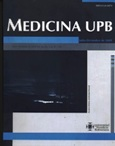Perfil clínico y epidemiológico de los pacientes con diagnóstico de Nefropatía por inmunoglobulina A. EPS Susalud, 2004 – 2007
Contenido principal del artículo
Resumen
Introducción: la Nefropatía por inmunoglobulina A (IgA) es considerada la primera causa de glomerulonefritis primaria en el mundo. Dicha enfermedad es causada por el depósito de complejos inmunes tipo inmunoglobulina A, que llevan a una glomerulopatía mesangial y proliferativa.
Objetivo: Describir el perfil clínico y epidemiológico de los pacientes con diagnóstico de Nefropatía por inmunoglobulina A de la EPS Susalud, durante el periodo 2004-2007.
Metodología: Se realizó un estudio de una serie clínica de pacientes mayores de 14 años, a quienes se les confirmó, por biopsia renal, el diagnóstico de Nefropatía por inmunoglobulina A y que estuvieran adscritos a la EPS Susalud de la ciudad de Medellín durante los años 2004 a 2007. La información de las variables fue extraída de las historias clínicas de los pacientes y, posteriormente, procesada en una base de datos en el paquete estadístico SPSS 11.0, con el que también se realizó el análisis de la información.
Resultados: En este estudio de 75 pacientes con IRC, se encontró que el grupo es de predominio femenino (60%), la hipertensión arterial coexistió con la Nefropatía por IgA en tres de cada cinco pacientes. Se observó que uno de cada dos pacientes tuvo proteinuria de 1 gramo y más, y al 28% de los pacientes de la serie se le diagnosticó síndrome nefrótico.
Conclusión: El estudio permite establecer que en este grupo de pacientes con Nefropatía por IgA existen características clínicas diferentes a las encontradas en otros estudios en el ámbito mundial, lo que justificaría la realización de estudios posteriores.
Referencias
D’Amico G. The commonest glomerulonephritis in the world: IgA nephropathy. Q J Med. 1987; 245:09-27.
Julian BA, Waldo FB, Rifai A, Mestecky J. IgA nephropathy, the most common glomerulonephritis worldwide: a neglected disease in the United States. Am J Med. 1988; 84:129-32.
Chobanian AV, Bakris GL, Black HR, et al. The Seventh Report of the Joint National Committee on Prevention, Detection, Evaluation, and Treatment of High Blood Pressure: the JNC 7 Report. JAMA 2003; 289: 2560- 72.
Shen P, He L, Huang D. Clinical course and prognostic factors of clinical early IgA nephropathy. Neth J Med. 2008; 66(6):242-7.
Shen P, He L, Li Y et al. Natural history and prognostic factors of IgA nephropathy presented with isolated microscopic hematuria in Chinese patients. Nephron Clin Pract. 2007; 106(4):157-61.
Woo KT, Edmondson RP, Wu AY, Chiang GS, Pwee HS, Lim CH. The natural history of IgA nephritis in Singapore. Clin Nephrol. 1986; 25(1):15-21.
Coppo R, D’Amico G. Factors predicting progression of IgA nephropathies. J Nephrol. 2005; 18(5):503-12.
Ibels LS, Györy AZ. IgA nephropathy: analysis of the natural history, important factors in the progression of renal disease, and a review of the literature. Medicine. 1994; 73(2):79-102.
Nozawa R, Suzuki J, Takahashi A, et al. Clinicopathological features and the prognosis of IgA nephropathy in Japanese children on long-term observation. Clin Nephrol. 2005; 64(3): 171-9.
Alamartine E, Sabatier JC, Guerin C, et al. Prognostic factors in mesangial IgA glomerulonephritis: an extensive study with univariate and multivariate analyses. Am J Kidney Dis. 1991; 18(1):12-9.
Lee HS, Lee MS, Lee SM, et al. Histological grading of IgA nephropathy predicting renal outcome: revisiting H. S. Lee’s glomerular grading system. Nephrol Dial Transplant. 2005; 20(2): 342-8.
Lee HS, Koh HI, Lee HB, et al. IgA nephropathy in Korea: a morphological and clinical study. Clin Nephrol. 1987; 27:131–40.
Lee SMK, Rao VM, Franklin WA, et al. IgA nephropathy: morphologic predictors of progressive renal disease. Hum Pathol. 1982; 13:314–22.
Meadow SR, Glasgow EF, White RHR, et al. Schönlein– Henoch nephritis. Q J Med. 1972; 41:241–58.
Lv J, Zhang H, Zhou Y, et al. Natural history of immunoglobulin A nephropathy and predictive factors of prognosis: a long-term follow up of 204 cases in China. Nephrology. 2008; 13(3):242-6.


